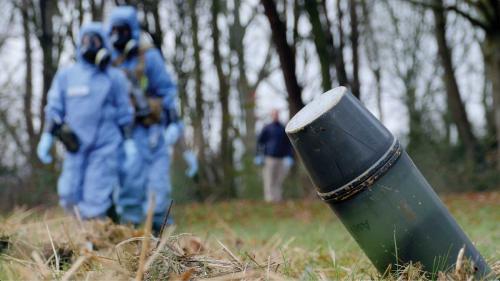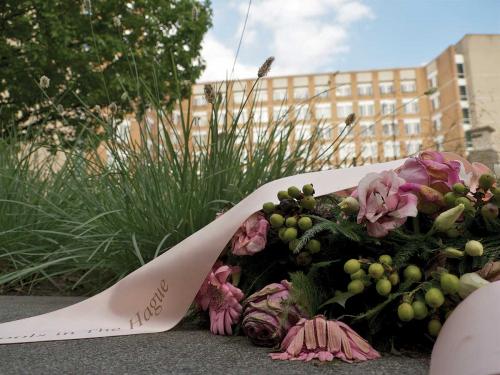In unbearable agony, men stagger blindly, choking on the chlorine fumes filling their trenches while the enemy descends swiftly towards them.
That was the horrible reality of chemical warfare during World War I. When the Germans launched the first chemical attack of the war, more than 5000 French and Algerian soldiers died. The Allies retaliated. The weapons of chemical warfare developed. Many, many more soldiers were maimed or killed. By the end of the Great War, chemical weapons had been responsible for more than one million casualties.
The chemical munitions of World War I are referred to as first-generation weapons. The World War II nerve agents are known as second generation, and Cold War agents are third generation. Now emerging, the fourth-generation ‘non-traditional’ agents include the binary nerve agents known as ‘novichocks’. Counterterrorism investigations and a public enquiry in Britain determined that this was used by the Russian Government in 2018 for the attempted murder of Sergei Skripal and his daughter in Salisbury, England, and the accidental murder of Dawn Sturgess, who four months later came into contact with the perfume bottle the agent had been stored in (bit.ly/3zizrOv).
These chemical agents are a terrifying reality. Choking agents, like chlorine and phosgene. Blister agents, like mustard gas. Blood agents, like hydrogen cyanide. Nerve agents. Incapacitants. Riot control agents, which have been used illegally as weapons of war, and have even killed protesters when used in high concentration. Herbicides, like Agent Orange, with long-term biological and ecological consequences.
Chemical warfare dates back nearly three millennia. As early as 600 BCE, the Athenian army poisoned the water supply of the besieged city of Kirrha with hellebore plants. A little over a century later, Peloponnesian forces used sulfur fumes against the town of Plataea. The use of chlorine for chemical warfare was proposed by both sides in the American Civil War, although neither side actually resorted to its use.
The international community quickly came to abhor the cruelties of chemical warfare. As early as 1675, the Strasbourg Agreement between France and Germany banned the use of poisoned bullets. In 1925, the Geneva Protocol made it illegal for treaty participants to employ chemical or biological weapons.
Nonetheless, between the Geneva Protocol and the later Biological and Toxin Weapons Convention of 1972, chemical agents were illegally used by Italy (Ethiopia, 1935–36), Germany (the Holocaust), Japan (Asia, World War II) and Egypt (Yemen 1960s). The use of a dioxin-containing herbicide as part of a US operation during the Vietnam War was not deemed illegal under international law at the time, but can be reasonably viewed today as being a form of chemical warfare that should not be considered acceptable. Iraq then used chemical weapons extensively against both military and civilian targets in Iran (1980–88) and within Iraq in cities such as Halabja. Numerous countries developed and accumulated vast stockpiles of chemical and biological weapons, more than enough to destroy all life on Earth.
It wasn’t until 3 September 1992 that the world saw a true turning point in this dreadful race. Thirty years ago, the United Nations Conference on Disarmament adopted the Chemical Weapons Convention (CWC). The treaty came into force in April 1997, 180 days after Hungary became the 65th country to ratify the treaty.
So began the slow and laborious process of disarming the world and ratifying the destruction of these deadly materials. By March this year, 99% of the world’s declared stockpiles – more than 72 000 tonnes of chemical death – had been destroyed (bit.ly/30F69FM). This has grown from 78% in 2013, and 96% in 2016.
The last to destroy its declared stockpiles, the US was hampered by its own Congress, which banned the transport of chemical munitions. It was forced to approve and construct destruction facilities in eight separate states, and has declared its plans to have the remaining stockpiles destroyed by 2023.
As the implementing body for the CWC, the Organisation for the Prohibition of Chemical Weapons (OPCW) has declared that as of March 2022, the total cost of this destruction process was nearly €72 billion (A$106 billion).
Of 97 declared chemical weapon production facilities, 74 have now been destroyed, and 23 have been converted to peaceful purposes. Four of these sites remain ‘inspectable facilities’, as do another 4939 industrial facilities worldwide.
Australia was an original signatory to the CWC on 13 January 1993 and was among the first nations to ratify it in 1994. Since 1995, the Australian Safeguards and Non-Proliferation Office (ASNO) has surveyed more than 3000 companies and organisations in Australia, to identify activities to be declared to the OPCW. About 150 companies or organisations were identified as having had relevant facilities or activities.
These days, 98% of the world’s population across 193 member states lives under the protection of the CWC. This is maintained by a rigorous system of inspections and verification, for which Australia plays an active role. In recognition of the incredible effort to eliminate chemical weapons, the OPCW was awarded the 2013 Nobel Prize for Peace.
As early as 1985, our government and scientists were instrumental in the establishment of the Australia Group – a voluntary and informal forum currently consisting of 42 countries and the EU – to establish and harmonise another layer of due diligence in export controls. Australia is the permanent Chair of the Australia Group.
Across five categories, the Australia Group establishes agreed ‘control lists’ of chemical weapons precursors; ‘dual-use’ biological equipment, technology and software; pathogens and toxins; and ‘dual-use’ chemical manufacturing facilities, equipment and technology. According to the Arms Control Association: ‘… the 42 member countries assert that the regime acts as an impediment to CBW [chemical and biological weapon] proliferation by working to ensure that industries in member nations do not, either inadvertently or intentionally, assist states or groups seeking to develop CBW capabilities.’
RACI member Dr Vanessa Robertson is Director of CWC Implementation within ASNO. Robertson was in Europe in July this year for the most recent Australia Group Plenary, commented to Chemistry in Australia that ‘Participants reaffirmed their commitment to strengthening chemical and biological weapons-related counter-proliferation efforts, and agreed it was a timely opportunity to further strengthen global endeavours to rid the world of chemical and biological weapons once and for all’.
Notwithstanding these international efforts, and the outstanding successes of the CWC over the last 30 years, the use of, and threat of, chemical weapons continues to plague our world. The United Nations Security Council has condemned the use of chemical weapons by Syria since 2013 in its ongoing civil war. At the Moscow theatre in 2002, Russia accidentally killed 125 of its own people when it exposed 750 hostages to overdoses of a fentanyl derivative in a rescue operation.
Arguably even more troubling, there have been multiple instances of the use of chemical agents by non-state groups, notably including the 1994 and 1995 attacks by AUM Shinrikyo in Japan, with 13 killed and more than 6000 people sickened or injured in the Tokyo subway attack of March 1995. An Al-Qaeda attack on the New York city subway was averted in 2005.
Speaking in March 2022, OPCW Director-General Ambassador Fernando Arias stated ‘As we draw closer to realising the disarmament goal of the Convention, we must increase our focus on preventing the re-emergence of chemical weapons use’.
As demonstrated by Syria (with at least 336 documented cases of the small-scale use of chemical weapons) and by Russia – both acting in criminal violation of their obligations as signatories to the CWC – there is a significant challenge in the policing of violations. A key issue has been that individual instances have been small scale and not necessarily meeting the threshold for intervention (although the US did launch missile strikes on Syrian facilities in 2017 as punitive response for specific attacks), while the benefit to the aggressor states accumulate over time with each successive use. Small-scale attacks are much harder to investigate, assess and attribute.
The same issue applies to the small-scale use of chemical weapons for targeted assassinations, as conducted by North Korea (Kim Jong-nam, Malaysia, 2017) and Russia. Beyond the 2018 Skripal poisoning mentioned earlier, the ABC has reported multiple Russian poisonings dating back as far as Lenin in 1919 (https://ab.co/3PJQleo). A British investigation also held Russia responsible for the 2006 radiological murder of Alexander Litvinenko, using polonium-210. Russia continues to refuse to cooperate with the OPCW to investigate the poisoning of Alexei Navalny, who was poisoned with a novichok nerve agent by the Russians in 2020 (bit.ly/3cxAIIG).
Russia has proved persistent in using its veto power in the UN Security Council to frustrate accountability for its use of chemical weapons. Russia and Syria consistently fail to cooperate with the OPCW, but there Russia has no veto so action proceeds. North Korea remains one of only four countries yet to accede to or ratify the CWC, and is believed to have the largest active stockpile in the world.
Chemical precursors remain another key challenge. The Centre for Strategic and International Studies notes that more than 15 000 new chemical substances are developed each day – more than 100 million new chemicals since the establishment of the CWC. Three of the top ten chemical producers, Russia, China and Brazil, all fall outside the precursor control regime; that is, they are not participants of the Australia Group. The backward-synthesis of known weapons from alternative and uncontrolled precursors remains a major problem.
Australia has recently committed an extra $350 000 to support the OPCW in developing additional scientific, chemical and operating capabilities, particularly forensic and analytical capabilities, to address the new and changing threats to international safety, and for assistance and protection activities in Ukraine.
The evolving nature of the challenge is a responsibility for us all. We have the opportunity to make a positive contribution through care and compliance.
Dima Korotayev of Reuters summed this up well: ‘Chemistry cannot be blamed for chemical warfare or terrorism, but the chemistry community has a duty to be aware of the danger and to act to prevent the misuse of chemicals. We must work to educate people about chemical safety, waste disposal and the responsible use of chemicals, starting at school’.





